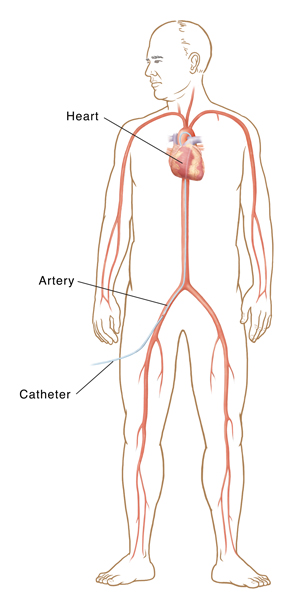Coronary Angiography
Angiography is a special type of moving X-ray that lets your doctor view your coronary arteries to see if the blood vessels to your heart are narrowed or blocked. This test is done when someone is having a heart attack. Or it may be done if symptoms may mean a heart attack. It also may be done after an abnormal cardiac stress test.
Before the procedure
-
Tell your healthcare team what medicines you take and any allergies you may have.
-
Tell your healthcare team if you've had a reaction to contrast dye or have had any kidney problems.
-
Follow any directions you are given for not eating or drinking before surgery.
-
A nurse will place an IV (intravenous) catheter in your vein to give fluids, and medicine to relieve pain and help you feel less anxious.
-
They clean your skin and shave the area where the catheter will be inserted, if needed.
During the procedure
-
You will lie on a table with a portable X-ray machine over you. The team will place a surgical drape over your body. The area where the doctor chooses to insert the catheter will be cleaned. This will be either a wrist or the groin.
-
Your doctor will place a long, thin tube (catheter) inside an artery in your groin or arm and guide it into your heart. You may feel pressure with the insertion of the catheter. A numbing medicine often is injected at the insertion site. This eases discomfort during the procedure.
-
They will inject a contrast dye through the catheter into your blood vessels or heart chambers. You may feel a warm sensation or feeling like you have to urinate when the contrast is injected. This is normal.
-
X-rays are taken to show images of the inside of your heart and coronary arteries.
 |
| The catheter can be placed into the groin, arm, or wrist. |
After the procedure
-
Your healthcare team will tell you how long to lie down and keep the insertion site still. The amount of time may depend on whether a closure device such as a stitch or collagen plug was used to close the opening made in your artery. The time you must be still may be shorter if one of these devices was used. The amount of time will also depend on if there is any bleeding at the catheter insertion site.
-
If the insertion site was in your groin, you may need to lie down with your leg still for several hours. If the insertion site was in your wrist, a pressure bandage may be put on the site. Or you may have closure device placed on the insertion site. It will be taken off when there is no sign of bleeding. If bleeding occurs, a nurse will put pressure on the area to control it.
-
A nurse will check your blood pressure and the insertion site often. This is to make sure you remain stable after the procedure.
-
You may be asked to drink fluid to help flush the contrast liquid out of your system.
-
Have someone drive you home from the hospital.
-
If your doctor uses angioplasty or a stent to treat a blocked artery, you may stay the night in the hospital. If there are multiple blockages that can't be fixed with a stent or angioplasty, you may need surgery to bypass the blockages. This is called coronary artery bypass graft surgery. Your doctor will explain the results of your test and what treatment options that may be best for you.
-
It’s normal to find a small bruise or lump at the insertion site. The lump may be the collagen plug or stitch that you feel, or a small bruise. These common side effects should disappear within a few weeks.
-
You will be given instructions by your healthcare team on recovering from the coronary angiography. In general, don't lift anything heavier than a gallon of milk for several days. This gives time for the puncture site in the artery wall to heal. Try not to get the puncture site wet. Don't put it under water. Showers are OK. Don't soak in a bathtub, swimming pool, or hot tub until the skin has healed.
When to call your healthcare provider
Call your healthcare provider right away if you have any of these:
-
Symptoms of infection. These include pain, swelling, redness, bleeding, or drainage at the insertion site.
-
Fever of 100.4°F (38°C) or higher, or as advised by your provider
-
Bleeding, bruising, or a lot of swelling where the catheter was inserted
-
Blood in your urine
-
Black or tarry stools
-
Any unusual bleeding
-
Irregular, very slow, or fast heartbeat
-
Dizziness
Call 911
Call 911if any of these occur:
-
Chest pain
-
Shortness of breath
-
Sudden numbness or weakness in arms, legs, or face, or difficulty speaking
-
The puncture site swells up very fast
-
Bleeding from the puncture site that does not slow down with firm pressure
-
Severe or increasing pain, numbness, coldness, or a bluish color in the leg or arm that held the catheter
Online Medical Reviewer:
Callie Tayrien RN MSN
Online Medical Reviewer:
Stacey Wojcik MBA BSN RN
Online Medical Reviewer:
Steven Kang MD
Date Last Reviewed:
2/1/2022
© 2000-2024 The StayWell Company, LLC. All rights reserved. This information is not intended as a substitute for professional medical care. Always follow your healthcare professional's instructions.